

[ SUNDAY TRAVEL ]
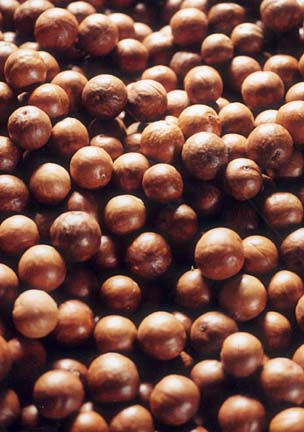
|
PAHOA, Hawaii >> I'm standing in a tidy garage built on the edge of a rain forest, staring at what looks like a small bazooka. But this "gun," which is connected to a computer, is loaded with nuts, not bullets, and it's not to aim at people, though the stack of uncracked macadamia in the clear chamber could do plenty of damage to bone and epidermis.
Life is good when you take the
time to visit the many macadamia
nut farms spread out across the Big IslandBy Tim Ryan
tryan@starbulletin.com
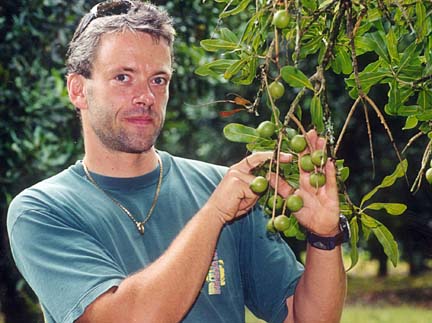
|
This is Mac's Nut Co. of Hawaii's processing farm and bed-and-breakfast, owned by Christian Bernadzik and Monika Nauen.The Big Island is home to more than 700 macadamia nut farms, and the Mac's Nuts enterprise is just one of several from Honokaa to Captain Cook that form the Big Island's "Great Hawaiian Mac Nut Trail," allowing visitors to learn all about the growing and processing of these delicious, hard-to-bust nuts.
I've just arrived at Mac's Nuts, which meant following directions by counting sign posts, mile markers and street corners, and avoiding dogs sleeping in the streets.
Home sites are spacious, well separated by ohia trees, mac nut groves or open, grassy fields. Privacy is the rule.
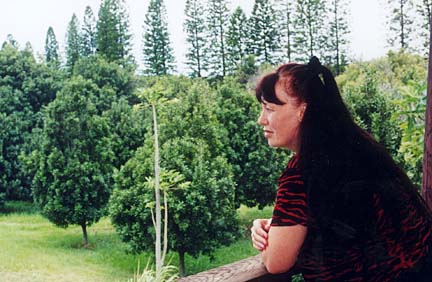
|
Christian gives me the key to a two-story A-frame building surrounded by tree ferns, crotons and wild orchids.The main room -- a living room, kitchen and dining table -- has a large fireplace with a stack of wood awaiting use. Several packs of Mac's Nuts sit on the coffee table.
I'm tempted to just crash, but I'm too curious about the nutcracker several mac growers have talked about.
For my three-night "Macadamia 101" journey, I'll concentrate on farms between Hilo and Kau that take me through several vegetation zones -- coastal, dry-land forest, mixed open forest, rain forest, subalpine and alpine -- making this route more interesting.
On my way to Mac's Nuts, I stopped at Mauna Loa Macadamia Nut Corp.'s visitor center a few miles east of Hilo Airport to see the processing.
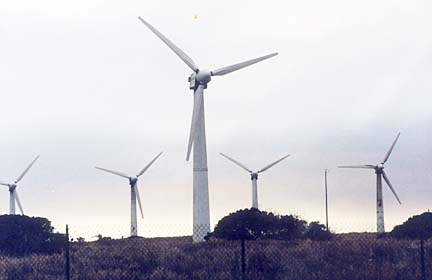
|
Macadamia picking season is July through December when some 150 company workers bag about 150,000 pounds of nuts a day -- 35 million to 40 million annually -- from the surrounding 2,500 acres, in addition to what hundreds of individual farmers bring in for processing.The rustic, multistory processing plant is surrounded by tall mounds of mac husks -- the nut's outer shell -- which will be burned as fuel to power the drying vats.
Here's the processing system: Nuts are dumped onto small trailers and taken to a washer where cold water and a scrubber remove 60,000 pounds of husks in eight hours. A conveyor belt takes the husked product to one of several large drying tanks kept between 80 to 100 degrees for the next week. The nuts then go to a second dryer for a final drying before cracking the inner shell.
The nuts are sorted by size, then rolled into crackers -- at $150,000 each -- where thickly grooved, 900-pound titanium balls break the nuts, leaving their kernels unscathed. It takes 1,800 pounds to crack a mac nut. Another machine shakes the cracked inner shells loose, leaving only golden kernels.
RANDY AHUNA'S 36-acre family farm is two miles east of Mauna Loa. In the midst of heavy rain, Ahuna is seated in a metal chair under a corrugated steel roof. Before we shake hands, he drops a dozen uncracked nuts in my palm.
"Try break 'em," he says, grinning.
I grab a large lava boulder, hitting the nut hard, with no luck. I throw it against a concrete slab; nothing. When I drop a 5-pound sledgehammer on it, the nut shoots out like a bullet, glancing off Ahuna's rubber boot.
The laughing farmer points to a table-mounted vice. I place the smooth, golden-brown shell between the steel walls, racking it tighter and tighter and tighter -- enough to crush bone, I reckon -- until there's a crunching sound and a distinct crack displays a flawless kernel.
"Think about doing 10,000 pounds a week," Ahuna says.
Ahuna is proud of his family's Garden of Eden, so it takes little prodding to convince him to give me a tour in his doorless truck.
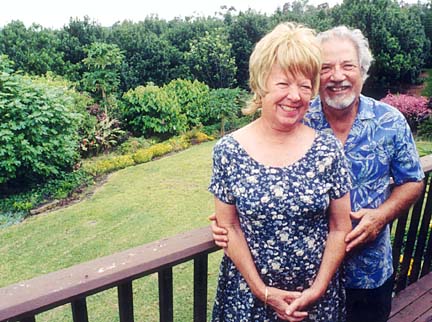
|
"This is where it started," he says pointing to a grove of 40-year-old mac trees.The farm now has more than 2,000 trees, producing about 400,000 pounds of nuts a year.
The macadamia tree flourishes in Hawaii's temperate to subtropical conditions. The tree may achieve a height of 60 feet, a spread of 40 feet and be productive for 60 years or more.
"They are part of my ohana," says Ahuna, who gives me a handful of husked nuts just before I set off to Mac's Nuts, where Christian Bernadzik's special shelling device is the Whaling F15 Starcracker -- named after inventor Bill Whaling, who lives in Kau. It can crack nuts still wet in the shell, which means the nut is processed fresher.
Bernadzik hands me ear protectors for the demonstration. The cracker uses compressed air to shoot the nut at 400 mph against an enclosed anvil. This knocks the husk off but keeps the inner shell intact for a piston to take care of a thousandth of a second later.
I stand several feet behind the cracker as Bernadzik puts a couple dozen nuts in the chamber, then makes some adjustments on an attached computer. I'm thinking a plastic shield and helmet would be better protection, in case an errant nut ricochets around the garage. But the machine works perfectly.
Bernadzik smiles, then puts the fresh nuts aside for tomorrow's pancake breakfast.
PART OF THE "Trail" experience is picking your own nuts, so Bernadzik drives me to Mac's Nuts' 16-acre grove of 1,100 trees. It's a sweltering day, but a half-dozen workers in long pants and long-sleeved shirts squat under trees picking nuts off the ground and putting them in burlap bags.
The nuts grow in tight, green clusters. Weeds are regularly removed from beneath the low-hanging branches to prevent fallen nuts from getting moldy. Mac nuts are only picked off the ground, never from the branch.
"Here," Bernadzik says, handing me an empty bag.
My enthusiasm is strong; my knees are not. It's not long before they ache from the squatting and my knuckles are scratched from scraping the lava ground when I try to retrieve several nuts at once. In only a few minutes, I am sweating profusely. I have, perhaps, a pound of nuts.
"I guess this is one reason they're so expensive," I tell Bernadzik.
Back at the farm, Bernadzik husks and cracks the nuts, and we take "my" product to Nauen, who is sorting according to size. She patiently tries to teach me the technique, but somehow I keep mixing extra large and the small, to the couple's amusement.
I retreat to my accommodations for a hot shower, then sample some Mac's Nuts.
The quiet just before dusk is astounding. A full moon rises above the forest, and stars fill the Hawaii night. I can see Nauen's silhouette as she continues to sort nuts into the night.
The next morning is clear and cool; there's a dew on everything. Bernadzik and Nauen serve a breakfast of macadamia nut coffee; ground mac nuts on thin, hot pancakes; and mac nut bread.
THE NUT, Bernadzik explains, is native to Australian rain forests, although Hawaii had the world's first commercial macadamia plantations.
"It was named after the Scottish-born scientist John Macadam after its discovery in 1857," he says. "It was originally thought of as only an ornamental tree."
In 1882, Big Island sugar plantation manager William H. Purvis introduced the nut to Hawaii. In the 1920s the macadamia nut's smooth, buttery flavor was discovered, and it began to attract attention in the agriculture industry.
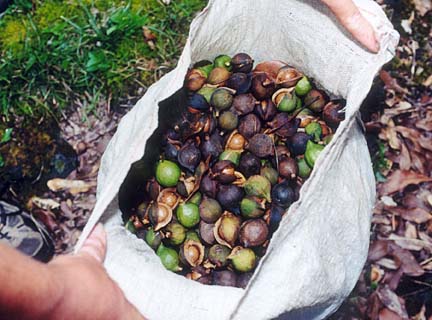
|
The important step for Hawaii came with the increase of commercial air travel in the 1960s. Airlines were looking for a more exotic snack than peanuts. So macadamia nuts in 3-ounce bags became the in-air fare for trans-Pacific passengers, the nut's distinctive flavor married with Hawaii's image.My next stop is Naalehu in the Big Island's Kau district. One of the driest, most isolated sections of the Big Island, also the southernmost tip of the United States, Naalehu is the site of Mac Farms of Hawaii, the world's single largest macadamia nut tree orchard.
The highway winds through several ecosystems from rain forests to lava desert. I'll be staying at Macadamia Meadows, a bed-and-breakfast with 220 three-decade-old mac trees spread over six acres, along with a tennis court and a solar-heated swimming pool.
First, I'll visit the transplanted Californians Anne and Dominic Abbriano and their 21-acre, 1,200-tree mac farm.
The winding 1,400-foot, two-lane driveway off Highway 11 weaves through the tidy, nearly weedless grove planted a dozen years ago. In front of the two-story cedar home is a sign: "Maluhia," Hawaiian for serenity.
It is misty, cool and inviting, but with no B&B facilities, I can only imagine what it would be like to stay here. Dominic greets me like a long-lost friend, offering me a cup of mac nut-flavored coffee.
"When we moved here we ... wanted to grow something," says Dominic, a retired United Airlines employee. "The macadamia nut is very forgiving of my stupidity."
"When I look at the orchard," says Anne, a former travel agent, "I know we've created something out of nothing. We have a quality of life here most people dream about."
We're standing on a large covered deck, watching the "wind farm" a dozen miles away near South Point. Before us are several acres of one-story mac trees swaying in the breeze. I take my time driving out of the property, even though I'm already tardy for my arrival at nearby Macadamia Meadows.
Charlene (pronounced "Char-lay-na") Cowan runs the place; husband Cortney makes the hour-plus drive each day to his Kona job. They started the bed-and-breakfast because, she says, "We couldn't live off of nuts alone."
The two-story main house is spacious with a few B&B rooms on the top floor and several on the ground, with easy access to the grove 100 yards away.
Macadamia Meadows sells its nuts to neighboring Mac Farms and via the Internet, and Cortney makes coffee with it.
It's late Sunday so the house is quiet, empty of weekend guests. My room looks onto the orchard. I lie down in the queen-size bed staring at the shaking leaves, then start to fall asleep when I catch myself.
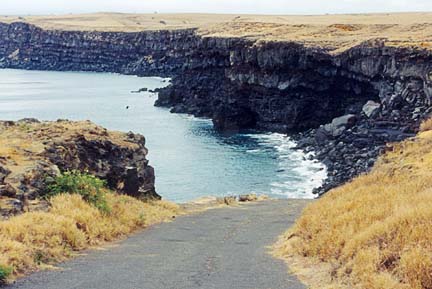
|
SOUTH POINT is a spot I always pass up on Big Island trips, but this time I promised myself a visit. I'm only a half-mile from the one-lane Ka Lae Road, which will steer me right to the rugged tip passing by orchards, grasslands, cattle ranches and parched, windswept soil.As the Kamoa Wind Farm grows closer, the whoosh-whoosh of wind turbines gets ominously loud. The wind always blows here. There is virtually no shade, so bring water.
The west side of the point is calm, deep and rocky; the east side is rocky and ferocious with nonstop waves pounding the near shoreline. South Point turns out to be an excellent place to relax, contemplate life and picnic.
It's dark by the time I get back to Macadamia Meadows, and the kitchen is closed. I head to Naalehu's main drag -- about three blocks long -- where the only restaurant open is Shaka's, at the 68-mile marker, where a sign reads, "Delicious home-cooked meals."
Two local families and a young couple are in the dining room where a Gordon Lightfoot-style entertainer sings to sporadic applause. The waitress hands me the night's special menu, a wrinkled yellow sheet of lined paper. The main menu warns that there's "no free refills for hot or iced tea" and "free coffee refills with food orders only."
I pass on the country fried steak in favor of the fresh ono with macadamia nut crust for $20.95.
By the time I return to Macadamia Meadow, the moon is full and high above. I grab a blanket off my bed and walk into the mac grove, where the tree's narrow branches allow easy access.
I spread the blanket, then lie down in an opening between six tall trees, staring at the moon, trying to count shooting stars.
I awake several hours later. The moon has disappeared and light is penetrating the darkness. It's the best rest I've had in months.
I quickly pack my bag, then bid Charlene and Cortney "aloha."
On my way out of town, I discover that the Naalehu Fruit Stand has just opened. I buy several fresh Kau oranges, a slice of warm macadamia shortbread and coffee.
The only radio station I can pick up out here in my rented SUV plays Hawaiian music. The mac bread is buttery, coffee steamy, oranges juicy.
Life is good.
The "Great Hawaiian Mac Nut Trail" is a self-guided tour of the Big Island's macadamia nut industry. Locations along the trail include Hawaii's largest macadamia nut plantation and processing plant, a small family-owned farm and a bed-and-breakfast stop where visitors can pick and eat their own mac nuts. It's possible take a mini-tour of either the Hilo or Kona coasts, or one that circles the island. Following is a list of the suggested stops. Some require an advance phone call to ensure someone's there to assist you. IF YOU GO
>> Big Island Candies, 585 Hinano St., Hilo; 808-935-8890. Makers of macadamia nut chocolates and cookies. Tours available for viewing the process. Open 8:30 a.m. to 5 p.m. daily. Visit www.bigislandcandies.com. MACADAMIA PROCESSORSEAST SIDE
>> Hamakua Macadamia Nut Co., 61-3251 Maluokalani Road, Kawaihae; 808-882-1116. Specializes in private-label products for gift-giving, including mac nut brittle and cookies. Nuts are processed in the Kawaihae factory 8 a.m. to 5 p.m. Mondays through Fridays.
>> Mauna Loa Macadamia Nut Corp., six miles south of Hilo on Macadamia Road, off Highway 11 between Hilo and Keaau; 808-966-8618. The 2,500-acre orchard has a nut-processing plant and chocolate factory where visitors can see mature trees and view the production of the nuts into macadamia nut products. Visitors may also view a video, take a nature walk and sample the nuts and candy. Open 8:30 a.m. to 5:30 p.m. daily. Visit www.maunaloa.com.
>> Kona Coast Macadamia Nut & Candy Factory, off Highway 11 in Honaunau between the 105- and 106-mile markers; 808-328-8141. A rustic experience with hands-on activities and viewing of the processing plant. Open 8 a.m. to 5 p.m. Mondays through Fridays, 8 a.m. to 4 p.m. Saturdays and 10:30 p.m. to 3 p.m. Sundays. WEST SIDE
>> Mac's Nut Co. of Hawaii, 13-3635 Nohea St., Pahoa; 877-965-1428. Vacation rental across the street from the mac farm allows visitors the opportunity to pick and husk their own mac nuts. About $105 per night. Visit www.macadamia-nut.com. BED-AND-BREAKFAST MACADAMIA FARMS
>> Lions Gate Bed & Breakfast, on Highway 11 between the 104- and 105-mile markers in Honaunau; 808-328-2335. Hosts Diane and Bill Shriner take visitors on tours of the five acres of macadamia trees. Visitors are allowed to pick up nuts, husk, crack and roast them. Visit www.kona-coffee-country.com/lionsgate.
>> Macadamia Meadows, 94-6263 Kamaoa Road on Highway 11 between the 65- and 66-mile markers; 808-929-8097. Guests may tour the 6-acre orchard with owner Charlene Cowan and learn about nutrition and history of the nuts. Guests may pick nuts, husk and crack them. Nuts are dehydrated, packaged with a personal label and ready for guests at checkout. Rates or $75 to $125 per night. Visit www.macadamiameadows.com.
>> Anne and Dominic Abbriano, 94-6698 Highway 11 between mile markers 68 and 69; 808-929-9101. Tour 21 acres filled with 1,300 mac trees. CALL-AHEAD VISITS
>> Randy and Margaret Ahuna's family farm, Highway 11 south to Ahuna Road; 808-959-7049. Visit 36 acres, of which 20 are planted with macadamia nuts.